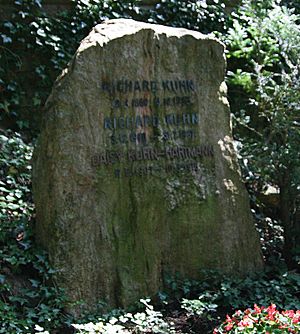Richard Kuhn facts for kids
Quick facts for kids
Richard Kuhn
|
|
|---|---|
 |
|
| Born |
Richard Johann Kuhn
3 December 1900 |
| Died | 1 August 1967 (aged 66) |
| Nationality | Germany, Austria |
| Awards |
|
| Scientific career | |
| Fields | Chemistry |
Richard Johann Kuhn (born December 3, 1900 – died August 1, 1967) was an Austrian-German biochemist. He won the Nobel Prize in Chemistry in 1938. He received this award for his important work on carotenoids and vitamins.
Contents
About Richard Kuhn
His Early Life and Education
Richard Kuhn was born in Vienna, Austria. He went to grammar school and high school there. He became interested in chemistry early on, but he had many hobbies. He decided to study chemistry later in his school years.
From 1910 to 1918, he was classmates with Wolfgang Pauli. Pauli later won the Nobel Prize in Physics in 1945. In 1918, Kuhn started attending chemistry lectures at the University of Vienna.
He finished his chemistry studies at the University of Munich. In 1922, he earned his doctoral degree. His research focused on enzymes, which are special proteins that help chemical reactions happen.
After getting his degree, Kuhn continued his science work. He worked in Munich, then at the ETH Zurich in Switzerland. In 1929, he moved to the University of Heidelberg in Germany. He became the head of the chemistry department there in 1937. In 1928, he married Daisy Hartmann. They had two sons and four daughters.
His Scientific Discoveries
Kuhn studied many areas in chemistry. He looked at how organic chemicals are built. He also studied how different chemicals get their colors. He did a lot of work in biochemistry, which is the chemistry of living things.
He focused on carotenoids, which are natural colors found in plants. He also studied flavins and vitamins. He did very important work on vitamin B2 and vitamin B6. Vitamin B6 helps prevent skin problems.
In 1929, he became the leader of the Institute for Chemistry. This was at the new Kaiser Wilhelm Institute for Medical Research in Heidelberg. This institute is now called the Max Planck Institute for Medical Research. By 1937, he was in charge of the whole institute.
Besides his work at the institute, he was also a professor. He taught biochemistry at the University of Heidelberg. For one year, he was a visiting professor at the University of Pennsylvania in Philadelphia.
The Nobel Prize and Later Years
Richard Kuhn won the Nobel Prize in Chemistry in 1938. The prize was for his "work on carotenoids and vitamins." However, he could not accept the prize at that time. Adolf Hitler, who was the leader of Germany, had forbidden German citizens from accepting Nobel Prizes. Kuhn explained in a letter that accepting the prize would go against Hitler's rules. He finally received the award after World War II ended.
Kuhn also discovered a chemical compound called Soman in 1944. After 1948, he became an editor for a science magazine called Justus Liebigs Annalen der Chemie.
Richard Kuhn passed away in 1967 in Heidelberg, Germany. He was 66 years old.
His Actions During the Nazi Era
During the time of Nazism in Germany, Richard Kuhn had connections with high-ranking Nazi officials. He supported the Nazi government through his work in science. This included some of his research that was later used for harmful purposes.
Because of his actions during this period, the Society of German Chemists (GDCh) made a decision in 2005. They decided to stop giving out a special award named after Richard Kuhn. The society explained that even though Kuhn was a great scientist, his behavior during the Nazi era meant he was not a suitable role model for an award.
Awards and Recognition
- 1938: Nobel Prize in Chemistry
- 1952: Wilhelm Exner Medal
- 1960: Honorary doctorate from the University of Vienna
- 1961: Austrian Decoration for Science and Art
See also
 In Spanish: Richard Kuhn para niños
In Spanish: Richard Kuhn para niños


